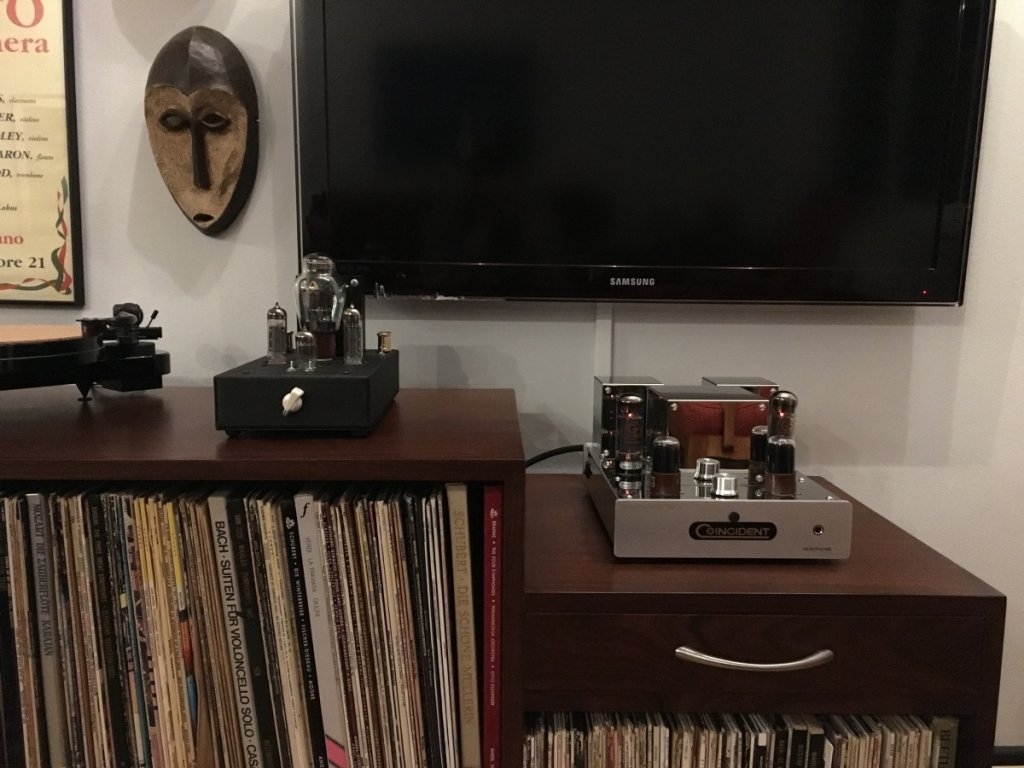Hi all,
I just spent a couple of weeks comparing low-watt amps from Decware (SE84UFO, 2 watts) and Coincident (Dynamo MkII, 8 watts) on my Omega Super 6 XRS Alnico. This was part of a series of experiments to get rid of a nagging harshness in the treble, and while I still haven't achieved that, it was a fun comparison. Bottom line, these are both fantastic amps, but I preferred the Decware overall.
The rest of the system is Audio Alchemy digital gear (DDP-1, DMP-1, and PS-5) and Black Cat Neo-Morpheus copper cabling. I mostly stream Tidal lossless files through roon. A cheap vinyl setup gets some play on occasion.
As background: the Coincident easily beat out my Red Wine Audio Signature 15 and Burson Timekeeper a while back on resolution, detail, transparency, and bass quality, and matched them both on tone color, if not density. The Red Wine and Burson were gone before I had the Decware, but from memory I believe the Decware's sound signature has much more in common with the Coincident than with either of those other amps (no surprise there).
With that context, here's what I heard:
The Coincident sounded more saturated overall than the Decware, with a meatier, wetter tone. There MAY have been a little more bass quantity overall, but I was surprised at how small the difference was on bass between eight watts and two. When I first started A/Bing the two amps I appreciated the Coincident's more saturated sound, which seemed to fill out images with more flesh and blood. It was also better with lower quality source material, which I always appreciate. At first listen I could tell that the Decware had a little more detail to offer, but it felt light and thin in comparison. First impressions went to Coincident.
I kept the Decware in my system for a week or so to let it - and my ears - settle in. Switching back to the Coincident was surprising. What I had first heard as better tonal density on the Coincident now felt slightly veiled and muddy in comparison to the Decware's directness and precisely defined imaging. I went back and forth on Chris Thile's new album "Thanks for Listening," and vocals just felt more present and communicative on the Decware, almost like blowing a thin layer of dust off a photograph.
The Decware was more transparent both on "they are here" recordings, like the Thile, and "you are there" recordings like my much-loved Michael Tilson Thomas rendition of Stravinsky's Firebird Suite. I could feel more of the hall with the Decware, and it was slightly better than the Coincident at rendering the spatial depth of a large ensemble. I was expecting the Decware's two watts to collapse under the pressure of a symphony with huge dynamic swings, but if anything, the Decware rendered both micro- and macrodynamics with slightly better thrust than the Coincident, including in the lowest frequencies. I had to turn up the volume higher on my preamp with the Decware, but I didn't detect a single bit of soundstage constriction or reduced composure in comparison to the Coincident. The only time the Decware ran out of steam was in home theater use with the volume up. I have heard the Death Star explode more convincingly with other amps...
I appreciated the Coincident's more saturated images and gentler treatment of bad recordings, but in the end, I couldn't say no to the Decware's directness, transparency, and spatial spookiness. And its tone is lovely; not as wet, but beautifully communicative and filled out in its own special way. I do think the Coincident is likely the more versatile amp, and if I had the budget to keep multiple amps around I would have done so, just in case I ever move away from the Omegas to speaker that benefits from a little more juice.
I always think I've hit the Omega's "ceiling" of maximum resolving power, and then once in awhile I'll bring a new component in that proves me completely wrong. It makes these speakers a joy to own over the long term. Thanks for bearing with the long post, and happy listening.
